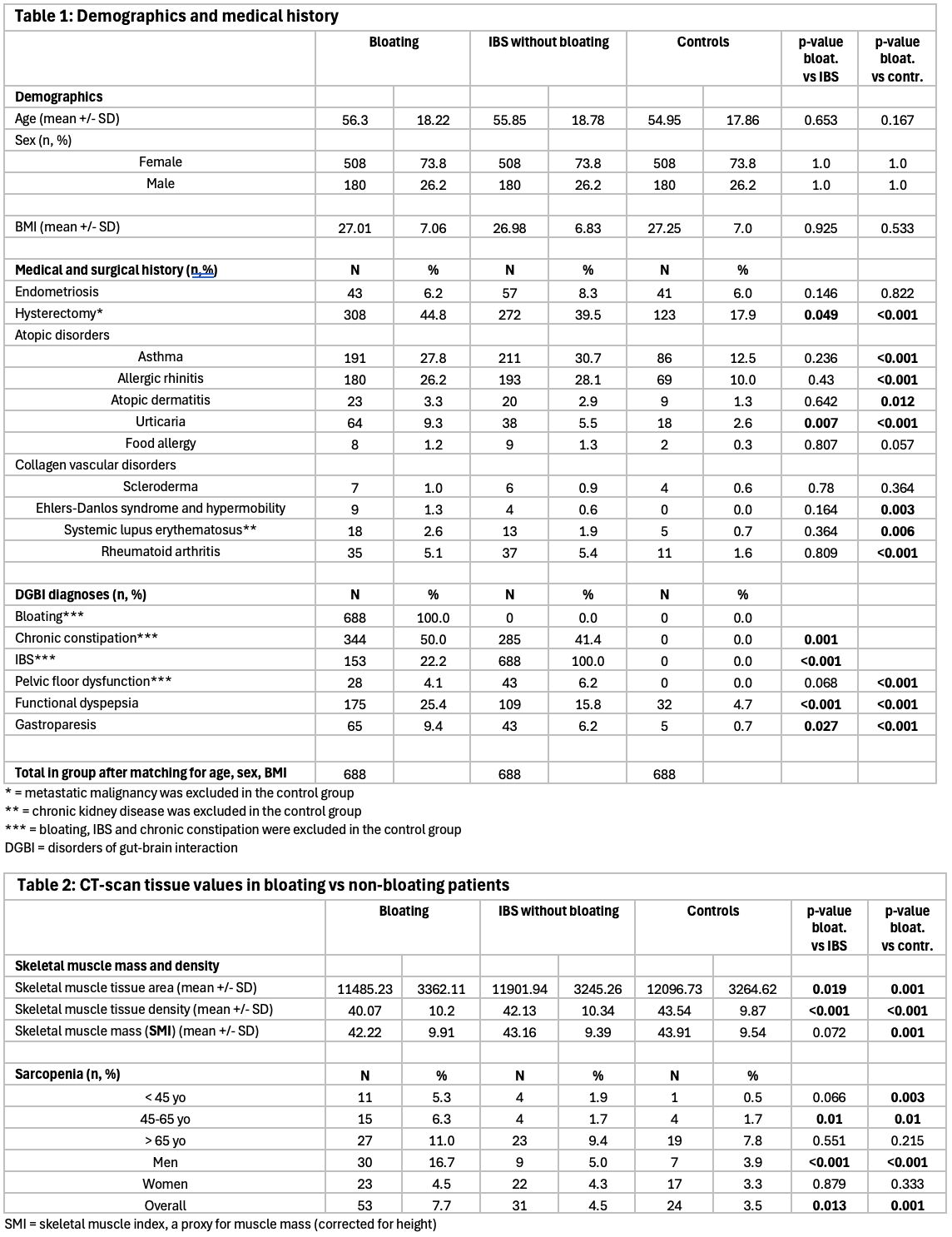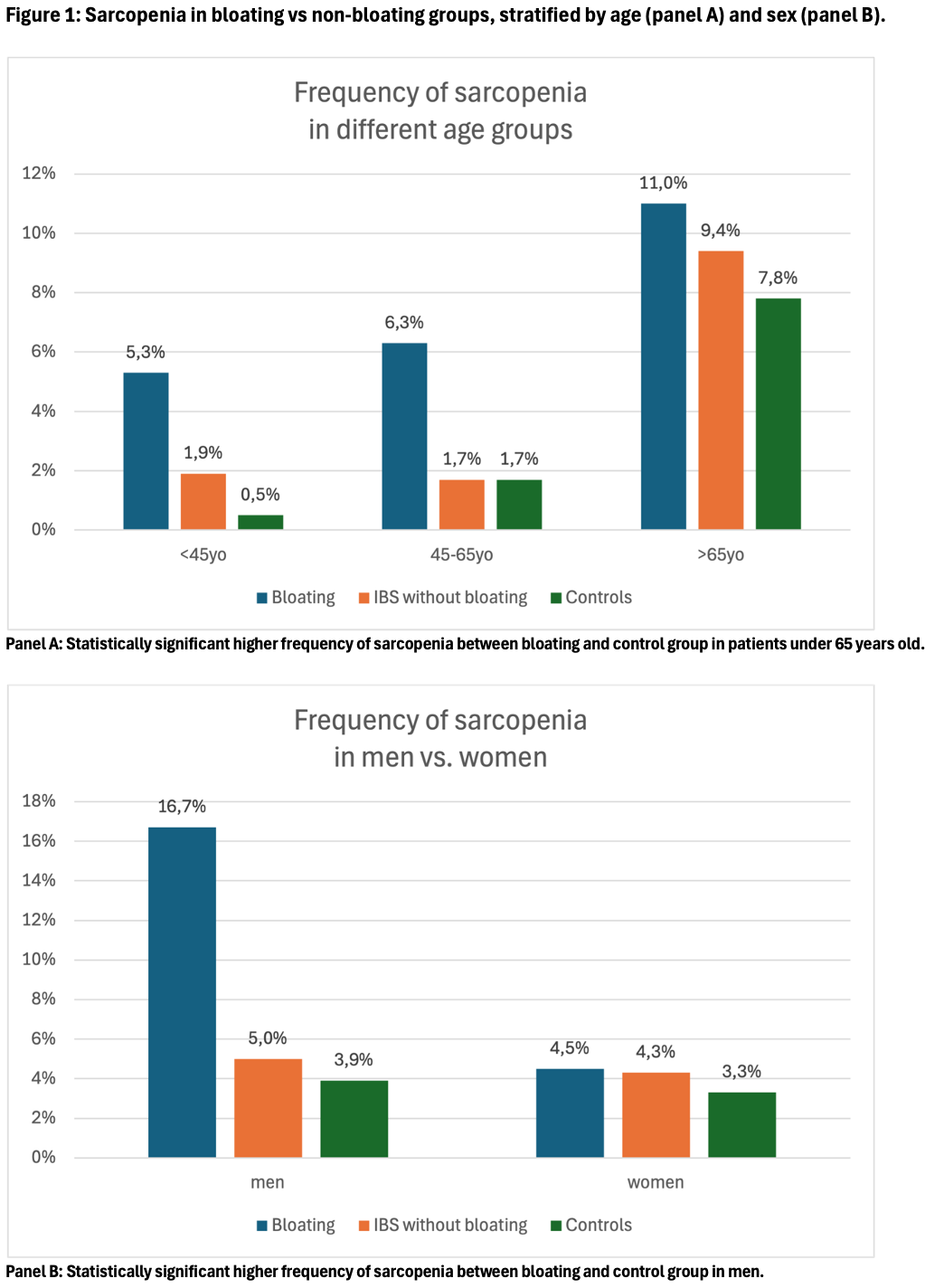Tuesday Poster Session
Category: Functional Bowel Disease
P5087 - Bloating Symptoms Are Associated With Low Muscle Mass: A Retrospective Automated Analysis of Abdominal CT Scans
Tuesday, October 28, 2025
10:30 AM - 4:00 PM PDT
Location: Exhibit Hall
- CS
Celine Soetaert, MD (she/her/hers)
Stanford University School of Medicine
San Francisco, CA
Presenting Author(s)
Celine Soetaert, MD1, Boutin Robert, MD2, Ates Fettahoglu, 2, Jason Wong, 2, Leila Neshatian, MD3, Sean Spencer, MD, PhD2, Akshay Chaudhari, MD2, Linda Nguyen, MD2
1Stanford University School of Medicine, San Francisco, CA; 2Stanford University School of Medicine, Stanford, CA; 3Stanford University, Stanford, CA
Introduction: Bloating and abdominal distension are common gastrointestinal complaints. While abdominal wall muscle contraction facilitates accommodation of gas in healthy individuals, it remains unclear whether low muscle mass influences this accommodation capacity. Abdominal CT scans performed for routine clinical indications can be automatically analyzed with artificial intelligence (AI) tools to screen patients for sarcopenia. We hypothesized that pre-existing CT scans can be used to evaluate the frequency of sarcopenia in patients with bloating as compared to controls without bloating.
Methods: In a retrospective study of patients over 18 years old who received an abdominal CT scan between 2014 and 2018, groups were identified by ICD-codes in a ‘bloating’, ‘IBS without bloating’ and a ‘healthy controls’ group, matched for age, sex and BMI. Demographics and medical history were collected from EHR. CT scans were used to measure muscle area and density at the L3 level with an open-source AI tool (Comp2Comp, Stanford). Sarcopenia was defined as a low skeletal muscle index (SMI). Statistical analysis was performed with Python using Pearson chi squared and unpaired t-test, p < 0.05 was regarded as significant.
Results: A total of 2064 patients were included (mean age 55 years old, 74% female, mean BMI 27). There were significantly higher rates of atopic disorders (asthma 28% vs 13%; allergic rhinitis 26% vs 10%; atopic dermatitis 3% vs 1%; urticaria 9% vs 3%), collagen vascular disorders (EDS and hypermobility 1% vs 0%; SLE 3% vs 1%; RA 5% vs 2%) and DGBI (functional dyspepsia 25% vs 5%; gastroparesis 9% vs 1%) in the bloating vs control group, respectively. There were significant differences in the muscle area and density between the three groups, with higher frequency of sarcopenia in the bloating vs IBS vs control groups (7.7% vs 4.5 vs 3.5%). After stratification by age and sex, this difference was significant between the bloating and control group in patients < 65 years old(5.9% vs 1.1%) and in men (16.7% vs 3.9%).
Discussion: Patients with bloating were more likely to have low abdominal muscle mass, with higher rates of sarcopenia in patients below the age of 65 years, as well as in men. Skeletal muscle mass evaluation identifies a subgroup of bloating patients who may benefit from strengthening of the abdominal wall muscles in their management. A prospective clinical trial is needed to further evaluate these findings.

Figure: Table 1: Demographics and medical history
Table 2: CT-scan tissue values in bloating vs non-bloating patients

Figure: Figure 1: Sarcopenia in bloating vs non-bloating groups, stratified by age (panel A) and sex (panel B).
Disclosures:
Celine Soetaert indicated no relevant financial relationships.
Boutin Robert indicated no relevant financial relationships.
Ates Fettahoglu indicated no relevant financial relationships.
Jason Wong indicated no relevant financial relationships.
Leila Neshatian indicated no relevant financial relationships.
Sean Spencer indicated no relevant financial relationships.
Akshay Chaudhari indicated no relevant financial relationships.
Linda Nguyen indicated no relevant financial relationships.
Celine Soetaert, MD1, Boutin Robert, MD2, Ates Fettahoglu, 2, Jason Wong, 2, Leila Neshatian, MD3, Sean Spencer, MD, PhD2, Akshay Chaudhari, MD2, Linda Nguyen, MD2. P5087 - Bloating Symptoms Are Associated With Low Muscle Mass: A Retrospective Automated Analysis of Abdominal CT Scans, ACG 2025 Annual Scientific Meeting Abstracts. Phoenix, AZ: American College of Gastroenterology.
1Stanford University School of Medicine, San Francisco, CA; 2Stanford University School of Medicine, Stanford, CA; 3Stanford University, Stanford, CA
Introduction: Bloating and abdominal distension are common gastrointestinal complaints. While abdominal wall muscle contraction facilitates accommodation of gas in healthy individuals, it remains unclear whether low muscle mass influences this accommodation capacity. Abdominal CT scans performed for routine clinical indications can be automatically analyzed with artificial intelligence (AI) tools to screen patients for sarcopenia. We hypothesized that pre-existing CT scans can be used to evaluate the frequency of sarcopenia in patients with bloating as compared to controls without bloating.
Methods: In a retrospective study of patients over 18 years old who received an abdominal CT scan between 2014 and 2018, groups were identified by ICD-codes in a ‘bloating’, ‘IBS without bloating’ and a ‘healthy controls’ group, matched for age, sex and BMI. Demographics and medical history were collected from EHR. CT scans were used to measure muscle area and density at the L3 level with an open-source AI tool (Comp2Comp, Stanford). Sarcopenia was defined as a low skeletal muscle index (SMI). Statistical analysis was performed with Python using Pearson chi squared and unpaired t-test, p < 0.05 was regarded as significant.
Results: A total of 2064 patients were included (mean age 55 years old, 74% female, mean BMI 27). There were significantly higher rates of atopic disorders (asthma 28% vs 13%; allergic rhinitis 26% vs 10%; atopic dermatitis 3% vs 1%; urticaria 9% vs 3%), collagen vascular disorders (EDS and hypermobility 1% vs 0%; SLE 3% vs 1%; RA 5% vs 2%) and DGBI (functional dyspepsia 25% vs 5%; gastroparesis 9% vs 1%) in the bloating vs control group, respectively. There were significant differences in the muscle area and density between the three groups, with higher frequency of sarcopenia in the bloating vs IBS vs control groups (7.7% vs 4.5 vs 3.5%). After stratification by age and sex, this difference was significant between the bloating and control group in patients < 65 years old(5.9% vs 1.1%) and in men (16.7% vs 3.9%).
Discussion: Patients with bloating were more likely to have low abdominal muscle mass, with higher rates of sarcopenia in patients below the age of 65 years, as well as in men. Skeletal muscle mass evaluation identifies a subgroup of bloating patients who may benefit from strengthening of the abdominal wall muscles in their management. A prospective clinical trial is needed to further evaluate these findings.

Figure: Table 1: Demographics and medical history
Table 2: CT-scan tissue values in bloating vs non-bloating patients

Figure: Figure 1: Sarcopenia in bloating vs non-bloating groups, stratified by age (panel A) and sex (panel B).
Disclosures:
Celine Soetaert indicated no relevant financial relationships.
Boutin Robert indicated no relevant financial relationships.
Ates Fettahoglu indicated no relevant financial relationships.
Jason Wong indicated no relevant financial relationships.
Leila Neshatian indicated no relevant financial relationships.
Sean Spencer indicated no relevant financial relationships.
Akshay Chaudhari indicated no relevant financial relationships.
Linda Nguyen indicated no relevant financial relationships.
Celine Soetaert, MD1, Boutin Robert, MD2, Ates Fettahoglu, 2, Jason Wong, 2, Leila Neshatian, MD3, Sean Spencer, MD, PhD2, Akshay Chaudhari, MD2, Linda Nguyen, MD2. P5087 - Bloating Symptoms Are Associated With Low Muscle Mass: A Retrospective Automated Analysis of Abdominal CT Scans, ACG 2025 Annual Scientific Meeting Abstracts. Phoenix, AZ: American College of Gastroenterology.
